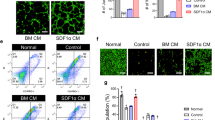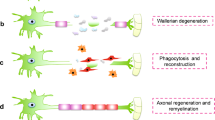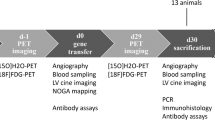Abstract
Ischemic peripheral neuropathy is a frequent, irreversible complication of lower extremity vascular insufficiency. We investigated whether ischemic peripheral neuropathy could be prevented and/or reversed by gene transfer of an endothelial cell mitogen designed to promote therapeutic angiogenesis. Intramuscular gene transfer of naked DNA encoding vascular endothelial growth factor (VEGF) simultaneously with induction of hindlimb ischemia in rabbits abrogated the substantial decrease in motor and sensory nerve parameters, and nerve function recovered promptly. When gene transfer was administered 10 days after induction of ischemia, nerve function was restored earlier and/or recovered faster than in untreated rabbits. These findings are due in part to enhanced hindlimb perfusion. In addition, however, the demonstration of functional VEGF receptor expression by Schwann cells indicates a direct effect of VEGF on neural integrity as well. These findings thus constitute a new paradigm for the treatment of ischemic peripheral neuropathy.
This is a preview of subscription content, access via your institution
Access options
Subscribe to this journal
Receive 12 print issues and online access
$209.00 per year
only $17.42 per issue
Buy this article
- Purchase on Springer Link
- Instant access to full article PDF
Prices may be subject to local taxes which are calculated during checkout






Similar content being viewed by others
References
European Working Group on Critical Leg Ischemia, Second European consensus document on chronic critical leg ischemia. Circulation 84, IV-1–IV-26 (1991).
Hunter, G.C., Song, G.W., Nayak, N.N., Zapotowski, D. & Guernsey, J.M. Peripheral nerve conduction abnormalities in lower extremity ischemia: the effects of revascularization. J. Surg. Res. 45, 96–103 ( 1988).
Miglietta, O. Electrophysiologic studies in chronic occlusive peripheral vascular disease . Arch. Phys. Med. Rehabil. 48, 89– 96 (1967).
Eames, R.A. & Lange, L.S. Clinical and pathological study of ischemic neuropathy. J. Neurol. Neurosurg. Psychiatry 30, 215–226 (1967).
Tsurumi, Y. et al. Direct intramuscular gene transfer of naked DNA encoding vascular endothelial growth factor augments collateral development and tissue perfusion . Circulation 94, 3281– 3290 (1996).
Bauters, C. et al. Physiologic assessment of augmented vascularity induced by VEGF in ischemic rabbit hindlimb. Am. J. Physiol. 267 , H1263–H1271 (1994).
Bauters, C. et al. Site-specific therapeutic angiogenesis following systemic administration of vascular endothelial growth factor. J. Vasc. Surg. 21, 314–325 ( 1995).
Bauters, C. et al. Recovery of disturbed endothelium-dependent flow in the collateral-perfused rabbit ischemic hindlimb after administration of vascular endothelial growth factor. Circulation 91, 2802– 2809 (1995).
Pu, L.Q. et al. A persistent hindlimb ischemia model in the rabbit. J. Invest. Surg. 7, 49–60 (1994).
Takeshita, S. et al. Vascular endothelial growth factor induces dose-dependent revascularization in a rabbit model of persistent limb ischemia. Circulation 90, II-228–II-234 (1994).
Takeshita, S. et al. Therapeutic angiogenesis following arterial gene transfer of vascular endothelial growth factor in a rabbit model of hindlimb ischemia . Biochem. Biophys. Res. Commun. 227, 628 –635 (1996).
Takeshita, S. et al. Therapeutic angiogenesis: A single intra-arterial bolus of vascular endothelial growth factor augments revascularization in a rabbit ischemic hindlimb model. J. Clin. Invest. 93, 662–670 (1994).
Rivard, A. et al. Age-dependent impairment of angiogenesis. Circulation 99, 111–120 ( 1999).
Isner, J.M. et al. Arterial gene transfer for therapeutic angiogenesis in patients with peripheral artery disease. Hum. Gene Ther. 7, 959–988 (1996).
Anton, E.S., Weskamp, G., Reichhardt, L.F. & Mattew, W.D. Nerve growth factor and its low affinity receptor promote schwann cell migration . Proc. Natl. Acad. Sci. USA 91, 2795– 2799 (1994).
Soker, S., Takashima, S., Miao, H.Q., Neufeld, G. & Klagsbrun, M. Neuropilin-1 is expressed by endothelial and tumor cells as an isoform-specific receptor for vascular endothelial growth factor. Cell 92, 735–745 (1998).
Patel, M.K., Lymn, J.S., Clunn, G.F. & Hughes, A.D. Thrombospondin-1 is a potent mitogen and chemoattractant for human vascular smooth muscle cells . Arterioscler. Thromb. Vasc. Biol. 17, 2107–2114 (1997).
Mellick, R.S. & Cavanagh, J.B. Changes in blood vessel permeability during degeneration and regeneration in peripheral nerves. Brain 91, 141–160 ( 1968).
Chervu, A., Moore, W.S., Homsher, E. & Quinones-Baldrich, W.J. Differential recovery of skeletal muscle and peripheral nerve function after ischemia and reperfusion. J. Surg. Res. 47, 12– 19 (1989).
Bentley, F.H. & Schlapp, W. Experiments on the blood supply of nerves. J. Physiol. 102, 62– 71 (1943).
Blunt, M.J. Ischemic degeneration of nerve fibers. Arch. Neurol. 2, 528–536 (1960).
Hobson, M.I., Brown, R., Green, C.J. & Terenghi, G. Inter-relationships between angiogenesis and nerve regeneration: a histochemical study. Br. J. Plast. Surg. 50, 125–131 (1997).
Takeshita, S. et al. Use of synchrotron radiation microangiography to assess development of small collateral arteries in a rat model of hindlimb ischemia. Circulation 95, 805–808 (1997).
Takeshita, S. et al. Endothelium-dependent relaxation of collateral microvessels after intramuscular gene transfer of vascular endothelial growth factor in a rat model of hindlimb ischemia. Circulation 98, 1261–1263 (1998).
White, F.C., Carroll, S.M., Magnet, A. & Bloor, C.M. Coronary collateral development in swine after coronary artery occlusion. Circ. Res. 71, 1490–1500 (1992).
Carroll, S.M., White, F.C., Roth, D.M. & Bloor, C.M. Heparin accelerates coronary collateral development in a porcine model of coronary artery occlusion . Circulation 88, 198–207 (1993).
Sondell, M., Lundborg, G. & Kanje, M. Vascular endothelial growth factor has neurotrophic activity and stimulates axonal outgrowth, enhancing cell survival and Schwann cell proliferation in the peripheral nervous system. J. Neurosci. 19, 5731–5740 ( 1999).
Sondell, M., Lundborg, G. & Kanje, M. Vascular endothelial growth factor stimulates Schwann cell invasion and neovascularization of acellular nerve grafts. Brain Res. 846, 219–228 (1999).
Osborne, W.A. & Vincent, S. The physiologic effects of extracts of nervous tissue. J. Physiol. 25, 283– 294 (1900).
Senger, D.R. et al. Tumor cells secrete a vascular permeability factor that promotes accumulation of ascites fluid. Science 219, 983–985 (1983).
Couffinhal, T. et al. A mouse model of angiogenesis. Am. J. Pathol. 152, 1667–1679 (1998).
Carmeliet, P. et al. Abnormal blood vessel development and lethality in embryos lacking a single VEGF allele. Nature 380, 435–439 (1996).
Ferrara, N. et al. Heterozygous embryonic lethality induced by targeted inactivation of the VEGF gene. Nature 380, 439– 442 (1996).
Rivard, A. et al. Rescue of diabetes related impairment of angiogenesis by intramuscular gene therapy with adeno-VEGF. Am. J. Pathol. 154, 355–364 (1999).
Couffinhal, T. et al. Impaired collateral vessel development associated with reduced expression of vascular endothelial growth factor in ApoE-1- Mice. Circulation 99, 3188– 3198 (1999).
Van Belle, E. et al. Hypercholesterolemia attenuates angiogenesis but does not preclude augmentation by angiogenic cytokines. Circulation 96, 2667–2674 (1997).
Morrissey, T.K., Kleitman, N. & Bunge, R.P. Isolation and functional characterization of schwann cells derived from adult peripheral nerve. J. Neurosci. 11, 2433–2442 (1991).
McCarthy, J.B., Palm, S.L. & Furcht, L.T. Migration by haptotaxis of a Schwann cell tumor line to the basement membrane glycoprotein laminin. J. Cell Biol. 97, 772–777 (1983).
Zigmond, S.H. & Hirsch, J.G. Leukocyte locomotion and chemotaxis: new methods for evaluation and demonstration of a cell-derived chemotactic factor. J. Exp. Med. 137, 387– 410 (1973).
Brogi, E. et al. Hypoxia-induced paracrine regulation of VEGF receptor expression . J. Clin. Invest. 97, 469– 476 (1996).
Spyridopoulos, I., Sullivan, A.B., Kearney, M., Isner, J.M. & Losordo, D.W. Estrogen-receptor-mediated inhibition of human endothelial cell apoptosis. estradiol as a survival factor. Circulation 95, 1505–1514 (1997).
Buttke, T.M., McCubrey, J.A. & Owen, T.C. Use of an aqueous soluble tetrazolium/formazan assay to measure viability and proliferation of lymphokine-dependent cell lines . J. Immunol. Methods 157, 233– 240 (1993).
Murohara, T. et al. Role of endothelial nitric oxide synthase in endotehlial cell migration. Arterioscler. Thromb. Vasc. Biol. 19, 1156–1161 (1999).
Kearney, M. et al. Histopathology of in-stent restenosis. Circulation 95, 1998–2002 ( 1997).
Acknowledgements
This study was supported in part by National Institutes of Health grants HL53354, HL57516, HL60911, the E.L. Wiegand Foundation, and the Peter Lewis Foundation. P.S. is the recipient of an Erwin Schroedinger fellowship grant, provided by the Austrian Ministry of Science.
Author information
Authors and Affiliations
Corresponding author
Rights and permissions
About this article
Cite this article
Schratzberger, P., Schratzberger, G., Silver, M. et al. Favorable effect of VEGF gene transfer on ischemic peripheral neuropathy . Nat Med 6, 405–413 (2000). https://doi.org/10.1038/74664
Received:
Accepted:
Issue Date:
DOI: https://doi.org/10.1038/74664
This article is cited by
-
VEGF overexpressed mesoangioblasts enhance urethral and vaginal recovery following simulated vaginal birth in rats
Scientific Reports (2023)
-
Intradialytic plantar electrical nerve stimulation to improve mobility and plantar sensation among adults with diabetes undergoing hemodialysis: a randomized double-blind trial
Journal of Nephrology (2023)
-
The relationship between vascular endothelial growth factor-A serum level and the severity of diabetic peripheral neuropathy
Egyptian Rheumatology and Rehabilitation (2022)
-
VEGF-A/VEGFR-1 signalling and chemotherapy-induced neuropathic pain: therapeutic potential of a novel anti-VEGFR-1 monoclonal antibody
Journal of Experimental & Clinical Cancer Research (2021)
-
Tramadol: a Potential Neurotoxic Agent Affecting Prefrontal Cortices in Adult Male Rats and PC-12 Cell Line
Neurotoxicity Research (2020)



